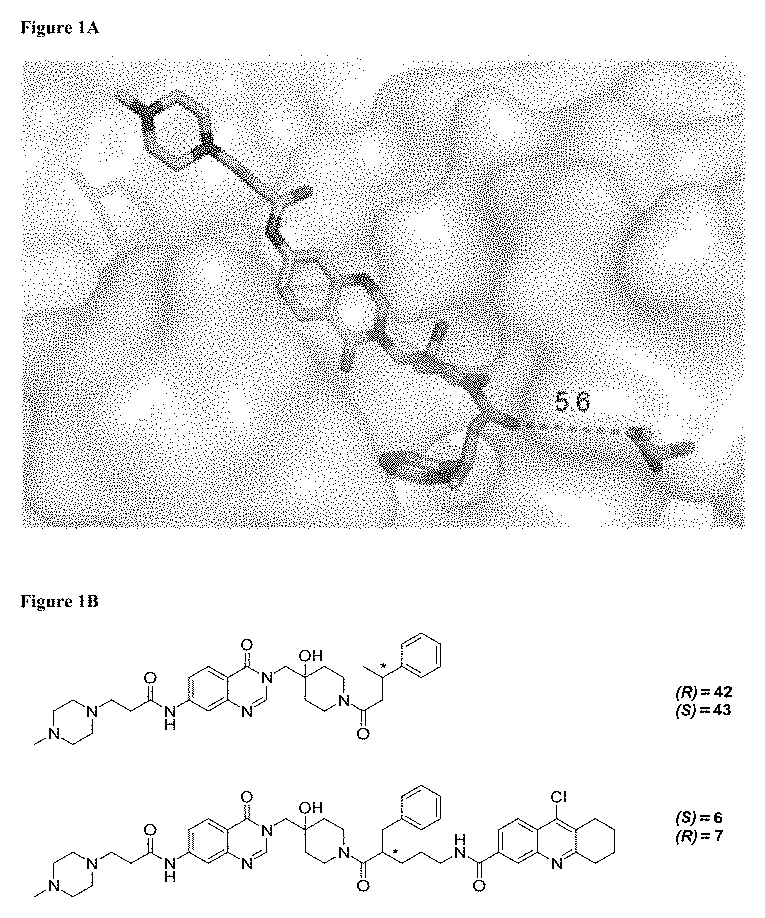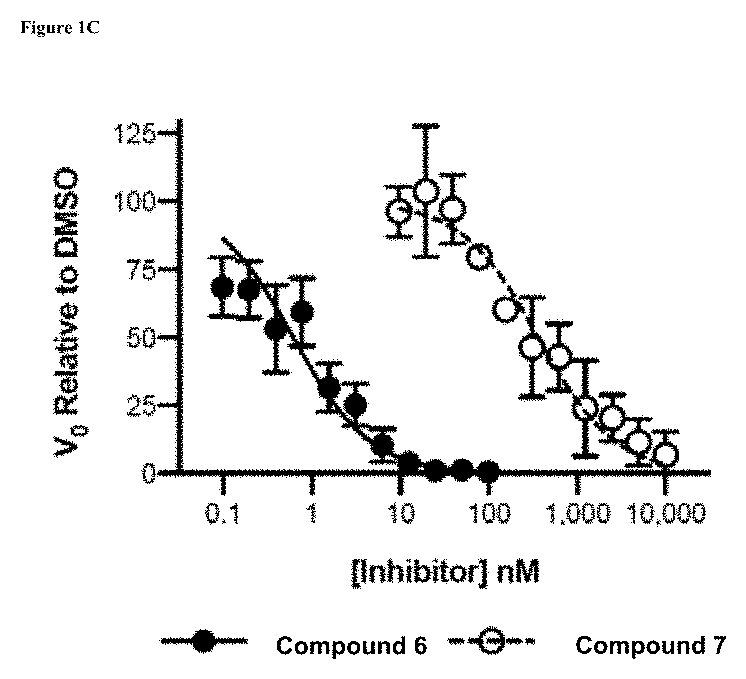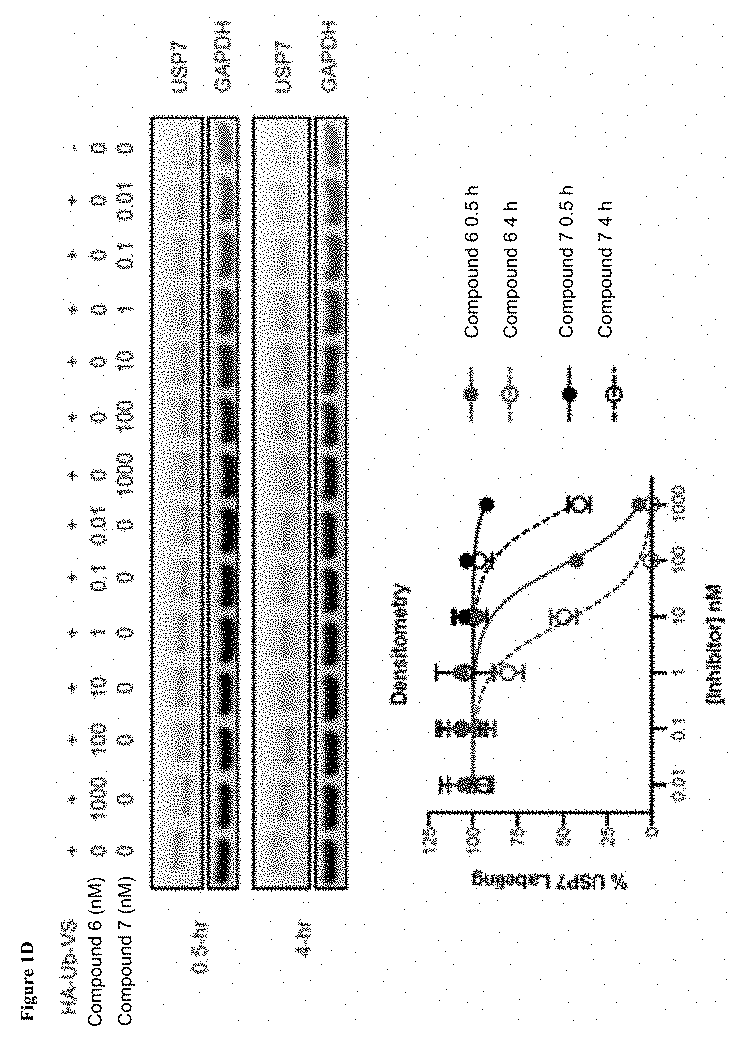Usp7 inhibition
a technology of usp7 and ligand, applied in the field of usp7 inhibition, can solve the problems of limiting the utility of target validation and mechanism studies, high resolution dub-small molecule ligand complex structure, and no structure-guided optimization effort has been reported for a mammalian dub
- Summary
- Abstract
- Description
- Claims
- Application Information
AI Technical Summary
Benefits of technology
Problems solved by technology
Method used
Image
Examples
example 1
on of Exemplary Compounds of the Disclosure
Analytical Methods, Materials, and Instrumentation
[0307]Unless otherwise noted, reagents and solvents were used as received from commercial suppliers. All commercially available starting materials were purchased from Sigma Aldrich, Fisher Scientific, Oakwood Chemical and Combi Block. All reagents were used as received without further purification. Known compounds were synthesized according to published literature procedures and any modifications are noted. Anhydrous solvents, such as tetrahydrofuran (THF), dichloromethane (DCM), dimethyl formamide (DMF), and dimethylsulfoxide were purchased from Fisher Scientific, and used as received. If necessary, air or moisture sensitive reactions were carried out under an inert atmosphere of nitrogen.
[0308]Removal of solvents was accomplished on a Büchi R-300 rotary evaporator and further concentration was done under a Welch 1400B-01 vacuum line, and Labconco FreeZone 6 plus system. Purification of com...
example 2
Assays Using Exemplary Compounds of the Disclosure
[0354]Enzymatic Assays with Exemplary USP7 Irreversible Inhibitors
[0355]Compound 42 is a noncovalent inhibitor of USP7 that binds in the thumb-palm cleft that guides the ubiquitin C-terminus into the active site. Specifically, a co-crystal structure of compound 42 and the USP7 catalytic domain shows the compound bound within the S4-S5 pocket of enzyme about 5 Å removed from the catalytic cysteine (FIG. 1A). Without being bound by any theory, given the proximity of the compound to the catalytic triad, it was hypothesized that the compound could be modified to develop covalent inhibitors that bind to the catalytic residue. In terms of rational design of such a compound, one challenge is the dynamics of the USP7 DUB domain. Crystallographic studies show that the catalytic triad resides in an inactive conformation, where the catalytic cysteine is 12 Å away from the Asp and His triad residues, in the apo- and compound 42-bound states but ...
example 3
ode of Exemplary Compounds
[0365]The search for potent and selective DUB inhibitors is of great interest to researchers interested in DUB biology. Despite advances in technology for DUB selectivity screening, including commercial DUB panels and ABPP methods, proteome-wide selectivity profiling has not previously been reported for DUB inhibitors. One of the most well-validated methods for proteome profiling is affinity chromatography, in which the small molecule of interest is conjugated to a solid resin via a solvent-exposed linker, exposed to native cell lysate, and enriched for any bound proteins. Terstappen, G. C., Schlüpen, C., Raggiaschi, R. & Gaviraghi, G. Target deconvolution strategies in drug discovery. Nat. Rev. Drug Discov. 6, 891-903 (2007). Drawbacks of this technique are that it requires that the affinity probe a) retain activity after conjugation of the linker, and b) bind irreversibly to target proteins either via crosslinking or covalent bond formation. The co-crysta...
PUM
 Login to View More
Login to View More Abstract
Description
Claims
Application Information
 Login to View More
Login to View More - R&D
- Intellectual Property
- Life Sciences
- Materials
- Tech Scout
- Unparalleled Data Quality
- Higher Quality Content
- 60% Fewer Hallucinations
Browse by: Latest US Patents, China's latest patents, Technical Efficacy Thesaurus, Application Domain, Technology Topic, Popular Technical Reports.
© 2025 PatSnap. All rights reserved.Legal|Privacy policy|Modern Slavery Act Transparency Statement|Sitemap|About US| Contact US: help@patsnap.com



